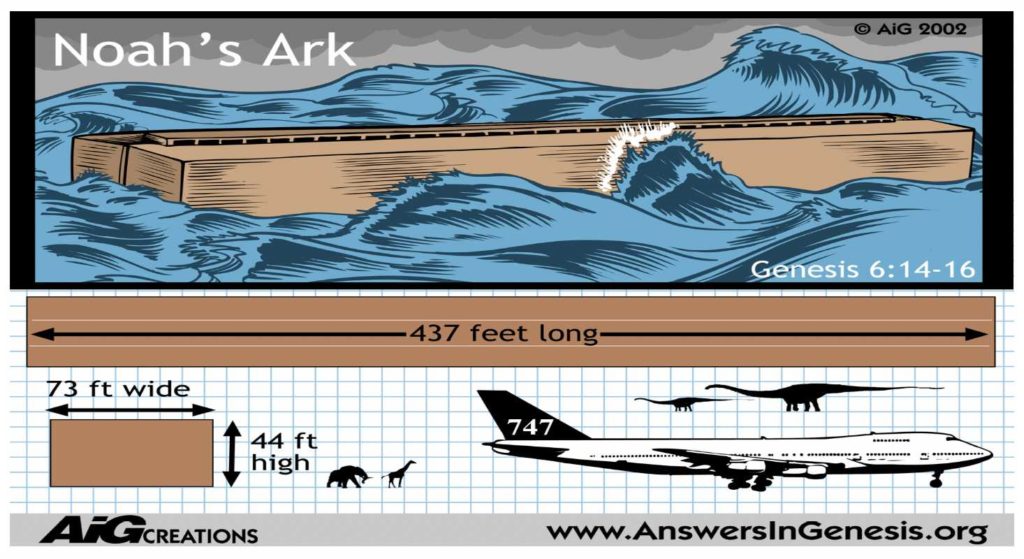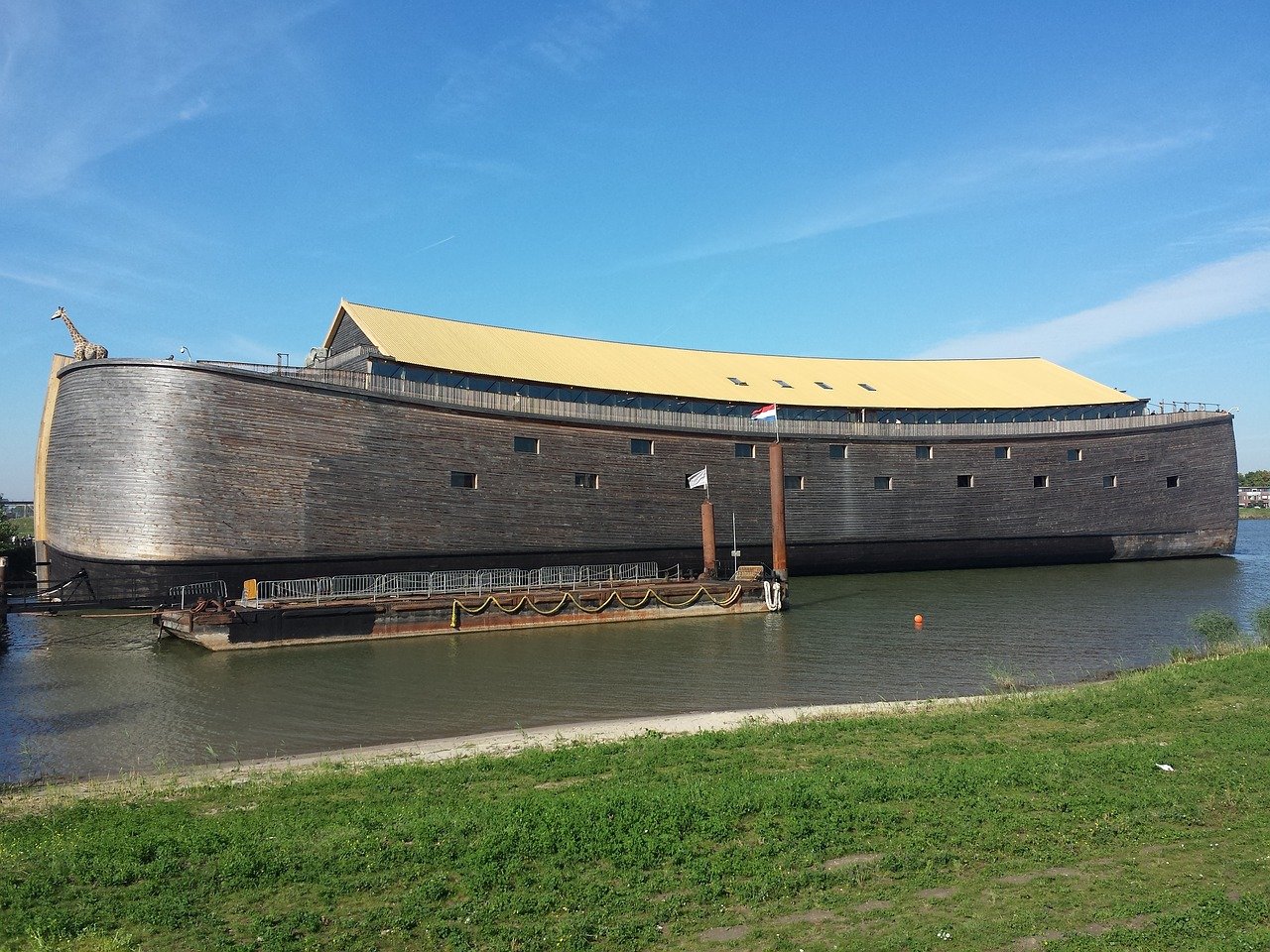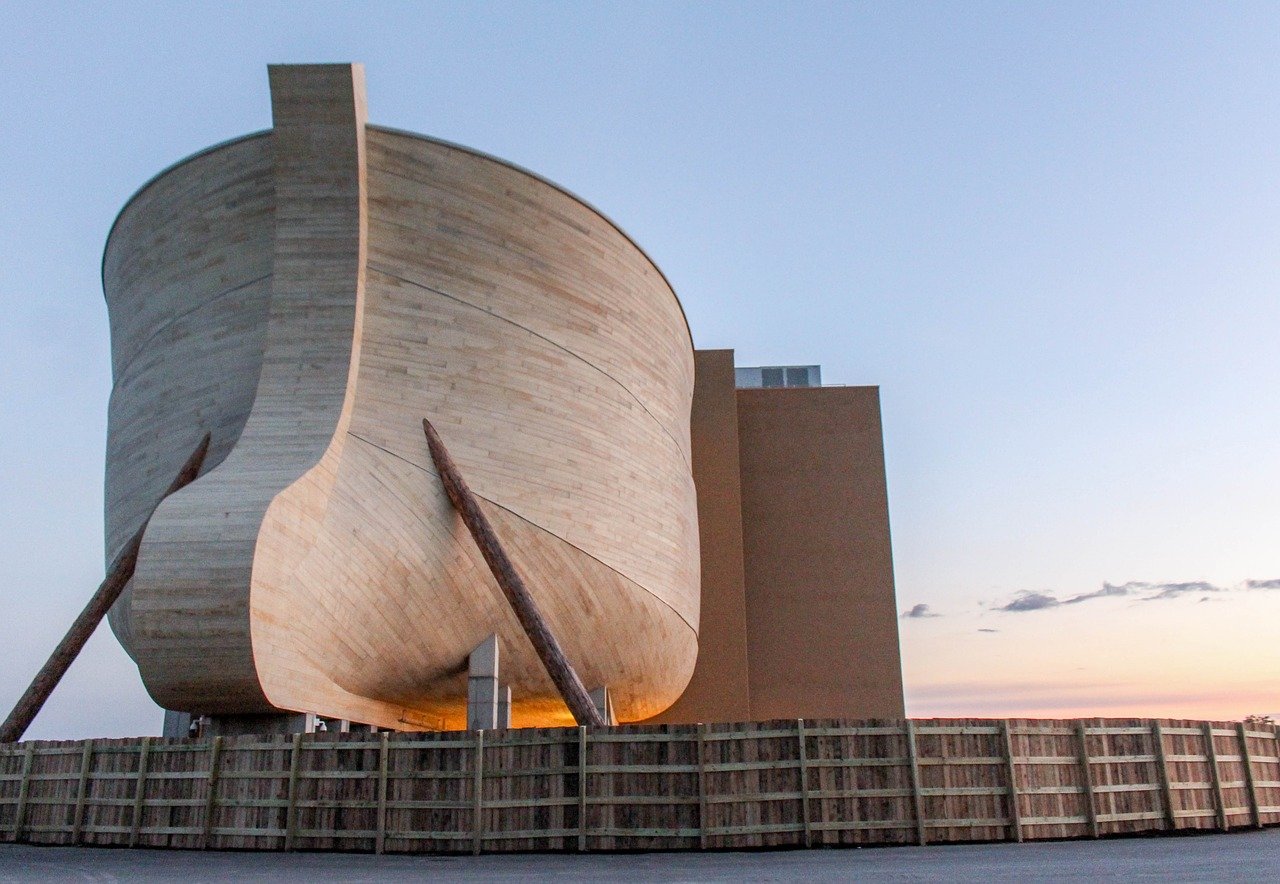Just as God has provided specific instruction for our generation to pass through the ‘waters of judgement’ and pass into the new world through Jesus Christ, so very detailed instruction was given to Noah for the construction of a massive sea-faring vessel which would be robust enough to survive the coming tide.
Based on the dimensions given in Genesis 6 scale reconstructions of the ark have been made. Contrary to modern playschool depictions of an oversized bathtub stuffed with smiling animals the ark was in fact an enormous barge-like vessel, perfectly designed to survive the roughest of storms.


The ark had a total deck of 97,700 square feet and was the largest ship ever built until 1884AD. The ark had the carrying capacity of 520 rail boxcars, ample room for the animals, food and provision and living quarters.
Noah’s Ark Replica In The Netherlands
Dutch contractor Johan Huibers built this replica of the Noah’s Ark in the Netherlands. Approximately to scale the replica is 1/2 the length and 1/3 the width of the Biblical dimensions. Life size models of giraffe, elephants, lions, crocodiles, zebras and other animals greet visitors as they arrive in the main hold. According to Genesis, Noah kept seven pairs of the most domesticated animals and one breeding pair of all other animals.
How did all the animals fit in the ark?
Taking into account that the ark was to carry representatives of each “kind” of animal (not every individual species), and its enormous size, there would have been no lack of space for the animals that boarded the ark. Many of the animals would have been juvenile specimens as well, thereby further reducing the space requirements. Feasibility studies have been conducted in this regard and an article by Jonathan Sarfati is included at the end of this sessions notes in this regard. Students are encouraged to read this article to help form a reasonable picture of the events described in Genesis.
The Global Flood
The Bible makes it clear that the flood was global in proportion.
“Now the flood was on the earth forty days. The waters increased and lifted up the ark, and it rose high above the earth. The waters prevailed and greatly increased on the earth, and the ark moved about on the surface of the waters. And the waters prevailed exceedingly on the earth, and all the high hills under the whole heaven were covered. The waters prevailed fifteen cubits upward, and the mountains were covered. And all flesh died that moved on the earth: birds and cattle and beasts and every creeping thing that creeps on the earth, and every man. All in whose nostrils was the breath of the spirit of life, all that was on the dry land, died. So He destroyed all living things which were on the face of the ground: both man and cattle, creeping thing and bird of the air. They were destroyed from the earth. Only Noah and those who were with him in the ark remained alive. And the waters prevailed on the earth one hundred and fifty days.”
Genesis 7:17-24
Some liberal commentators seek to convince readers that the flood was localised but the Scriptures clearly deny this.
Some liberal commentators seek to convince readers that the flood was localised but the Scriptures clearly deny this.
Reasons to reject the idea of a merely Mesopotamian flood include:
If the flood was local…
- How could the waters rise 15 cubits (8 metres) above the mountains (Gen 7:20)? Water seeks its own level. It couldn’t rise to cover the local mountains while leaving the rest of the world untouched.
- People who did not happen to be living in the vicinity would not be affected by it. They would have escaped God’s judgement of sin. If this happened, what did Christ mean when He likened the coming judgement of all men to the judgement of ‘all’ men (Matthew 24:37-39) in the days of Noah? A partial judgement in Noah’s day means a partial judgement to come.
- God would have repeatedly broken His promise never to send a flood again.
- Why did Noah have to build an Ark? He could have walked to the other side of the mountains and missed it.
- Why did God send the animals to the Ark so they could escape death? There would have been other animals to reproduce that kind if these particular ones had died.
- Why was the Ark big enough to hold all kinds of land vertebrate animals that have ever existed? If only Mesopotamian animals were aboard, the Ark could have been much smaller.
- Why would birds have been sent on board? These could simply have winged across to a nearby mountain range.
Secular evidence also lends strong support to the historical fact of a worldwide flood. Willmington records several (Willmington’s Guide to the Bible, Tyndale, pp28-29):
- Flood traditions can be found in the history of every ancient civilization and culture. The early inhabitants of nearly every country of the world have preserved records of the universal flood. Dr. Richard Andree collected forty-six flood legends from North and South America, twenty from Asia, five from Europe, seven from Africa, and ten from South Sea islands and Australia.
- Marine fossils have been found atop mountains. Scientists of the nineteenth century were dismayed to find that, as high as they climbed, the rocks yielded skeletons of marine animals, ocean fish, and shells of mollusks. Thus, in ancient days, flood waters streamed over Mount Everest and all other mountains. A whale’s skeleton was once found on the top of Mount Sanhorn on the Arctic Coast, and other similar skeletons a mile high on California’s coastal range.
- Many fossil “fish beds” exist all over the world. The Science Magazine, January 9, 1959, states: “More than a billion fish averaging 6 to 8 inches in length died on 4 square miles of bay bottom off the California Coast line.” Ivan Velikovsky writes: “When a fish dies its body floats on the surface or sinks to the bottom and is devoured rather quickly, actually in a matter of hours, by other fish. However, the fossil fish found in sedimentary rocks is very often preserved with all its bones intact. Entire shoals of fish over large areas, numbering billions of specimens, are found in a state of agony, but with no marks of a scavenger’s attack.” (Earth in Upheaval, p. 222)
- Because of the worldwide animal fossil graveyards. Robert Broom, South African paleontologist, estimated 800 billion skeletons of vertebrate animals exist in the Karroo formation alone. To this can be added the tens of thousands of fossils of all kinds found in the LaBrea tar pits in Los Angeles, California.
- Evidence of water bodies in present desert areas.
- The universal occurrence of rivers in valleys too large for the present system.
- Evidence from the geologic column suggests two things:
(1) That there was a continuous deposition of the stratum layers from beginning to end. There is no erosion in between the layers. In fact, in some layers there are actual ripple marks. In other stratums there exists one or more vertical tree trunks, with the same tree making its way up from top to bottom!
(2) That fossils from supposed different “ages” in the evolutionary theory actually lived at the same time!






